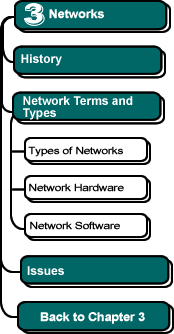

|
Cables
One way of creating a physical connection between computers is with cabling. The most conventional way to transmit information is by sending an electrical signal down a copper wire. Because plain copper wire is highly susceptible to electromagnetic interference (which is not good for communication between computers), it is almost never used by itself in a computer network. Instead, one of two kinds of wire is used: twisted pair or coaxial cable. In both twisted pair and coaxial cable, electricity moves at the speed of electrons through copper, which provides the potential for reasonably high bandwidth.
 Twisted
pair cable consists of two wires twisted together, only one of
which carries the information. This simple, inexpensive technique is the
approach used in telephone lines. It produces two benefits:
Twisted
pair cable consists of two wires twisted together, only one of
which carries the information. This simple, inexpensive technique is the
approach used in telephone lines. It produces two benefits:
- the second wire absorbs some of the electromagnetic energy emitted by the wire carrying the signal, reducing the interference this pair might cause to neighboring pairs
- the second wire also absorbs any electromagnetic interference coming from outside the pair, reducing the interference received by the wire carrying the information.
The most common grade of twisted-pair network cable is known as "category five," or CAT 5.

 Twisted
pair cabling uses a snap-in modular connector similar to that used to
connect a telephone cord into a phone jack, although it is a big larger.
Twisted
pair cabling uses a snap-in modular connector similar to that used to
connect a telephone cord into a phone jack, although it is a big larger.
This type of cabling scheme is often referred to with the BaseT suffix: e.g., "10BaseT." Again, when you hear this term, simply substitute the word network.
 Coaxial
cable consists of a single copper wire surrounded by insulation
that is itself surrounded by a flexible metal cylindrical sheath. This
is the approach used by cable-TV companies. Because the metal sheath completely
surrounds the wire carrying the signal, coaxial cable is far more expensive
than twisted pair. For the same reason, it does a far better job of shielding:
the wire is well protected from external electromagnetic interference.
This kind of cabling is often denoted with the suffix Base2—e.g.,
"10base2."
Coaxial
cable consists of a single copper wire surrounded by insulation
that is itself surrounded by a flexible metal cylindrical sheath. This
is the approach used by cable-TV companies. Because the metal sheath completely
surrounds the wire carrying the signal, coaxial cable is far more expensive
than twisted pair. For the same reason, it does a far better job of shielding:
the wire is well protected from external electromagnetic interference.
This kind of cabling is often denoted with the suffix Base2—e.g.,
"10base2."
Unfortunately, the terms "10BaseT" and "10Base2" are all too easily confused. Try to remember: in 10BaseT, T stands for "twisted."
![]()
![]()
This chapter was written by Jeff Nyhoff and Joel Adams. Copy editing by
Nancy Zylstra
©2005 Calvin University (formerly Calvin College), All Rights Reserved
If you encounter technical errors, contact computing@calvin.edu.